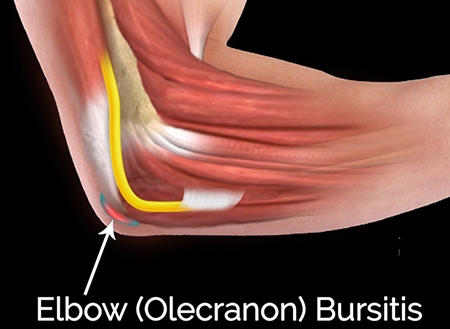In our previous blog, we discussed trochanteric bursitis in the region of the hip. However, bursitis also occurs regularly in the region of the elbow. This is called olecranon bursitis as it is the olecranon bursa that becomes inflamed. It presents differently from trochanteric bursitis in that a visible pocket of fluid is often prominent. In addition to this pocket of fluid, patients complain of pain, redness, and warmth.
Olecranon bursitis typically stems from three causes-trauma, infection, or inflammation. Single event trauma to the elbow such as hitting it on a door jam or repetitive trauma such as continually resting your elbow on the window in the car can cause an inflammatory process to occur. The bursa becomes inflamed and forms a pouch of fluid that sits uncomfortably off the tip of the elbow. Treatment includes ice, compression, and avoidance of further trauma with application of elbow pads.
Alternatively, an infectious process can cause swelling, warmth, and discomfort to this region. If your physician removes fluid from this pocket, it will likely appear cloudy or even look like pus. Treatment can vary based on the severity of the infection present. If caught early, a course of oral antibiotics may suffice. Sometimes, this regimen is done in conjunction with removing the fluid and applying compression. If the infection is more aggressive, your physician may use a scalpel to make a small incision that is packed with antibacterial strips. Ultimately, if the infection cannot be managed conservatively, surgery to wash out the area may be warranted. This only happens in rare cases.
Olecranon bursitis can also occur due to an inflammatory process not induced by trauma. Often, this takes the form of gout. This diagnosis can be confirmed by removing fluid to send to the lab for testing. Typically, gout flares are managed by oral medications. Sometimes, a regular regimen is recommended to prevent future flare-ups. Inflammation can also be spurred by rheumatoid arthritis, which is also managed by a prescribed regimen of oral medications from a rheumatologist.
Regardless of the origin of olecranon bursitis, the mainstays of treatment are compression, ice, and avoidance of trauma. If your elbow becomes swollen, red, and painful, you should see a physician for further work-up and testing so that it can be treated appropriately and in a timely fashion before it becomes more of a problem.
This blog is written by one of our very own-Morgan. She is a certified athletic trainer working in our clinic with our providers each and every day. She obtained a bachelor’s degree in athletic training from Carroll University in Waukesha and a master’s degree in Kinesiology from Michigan State University.

